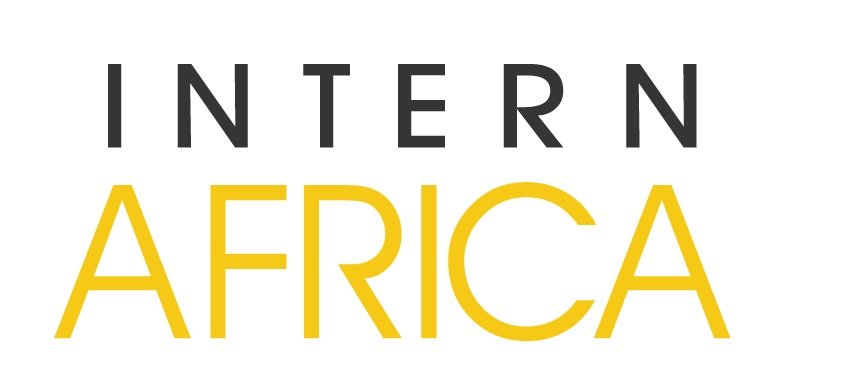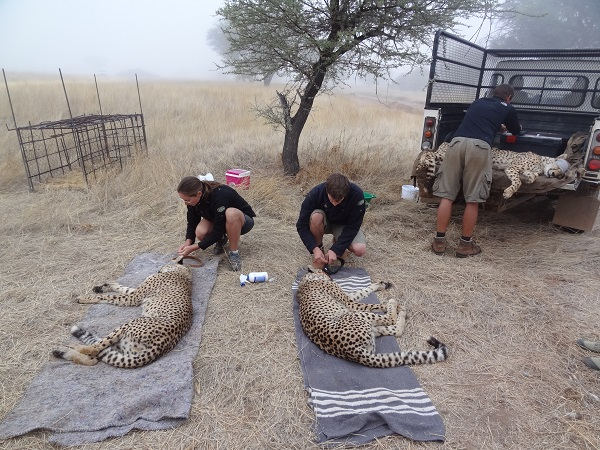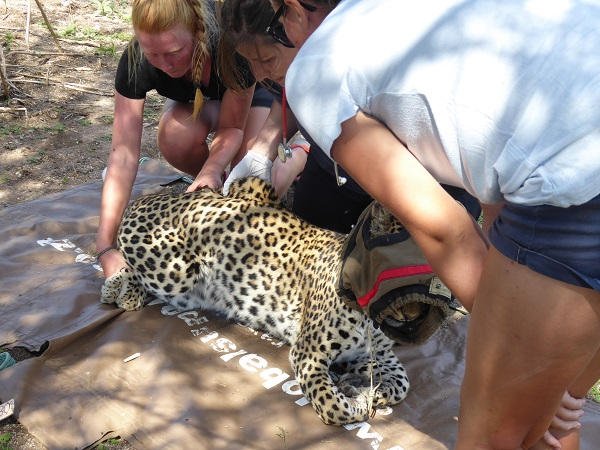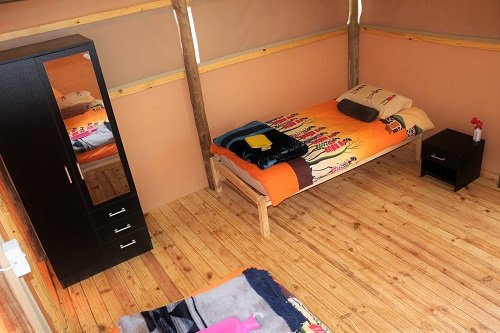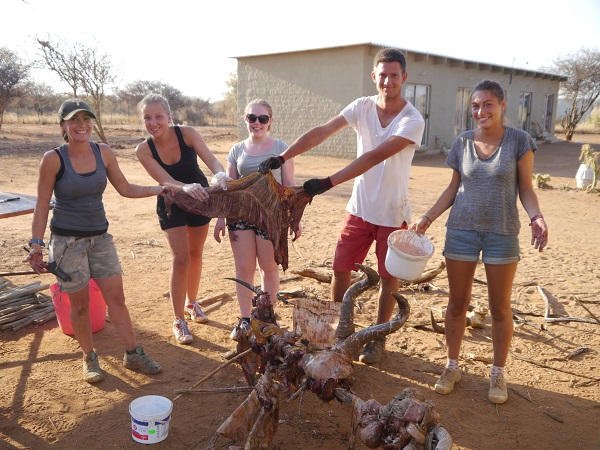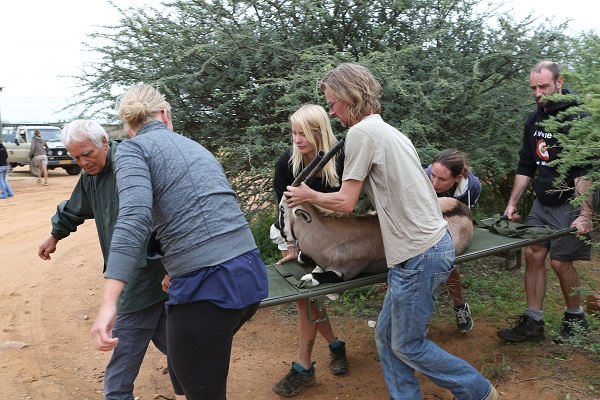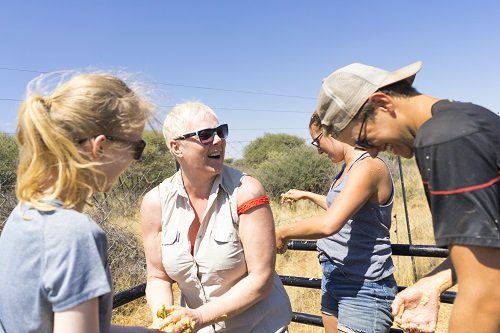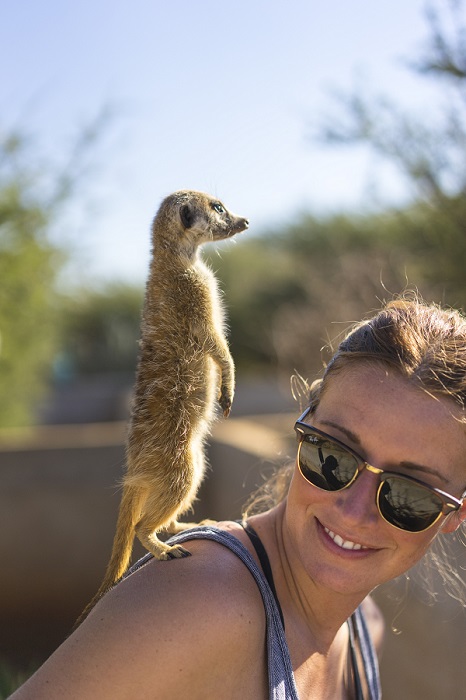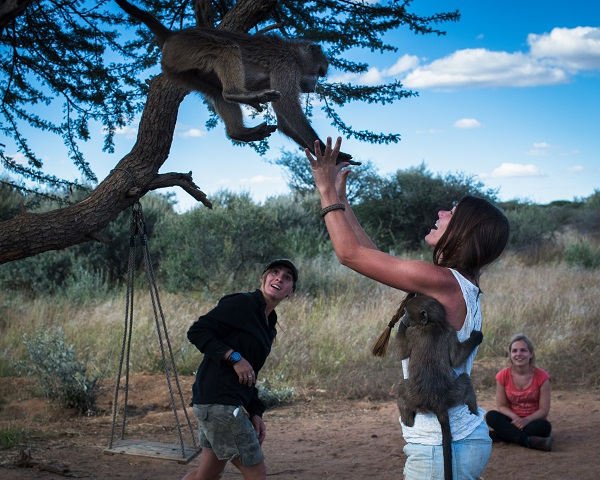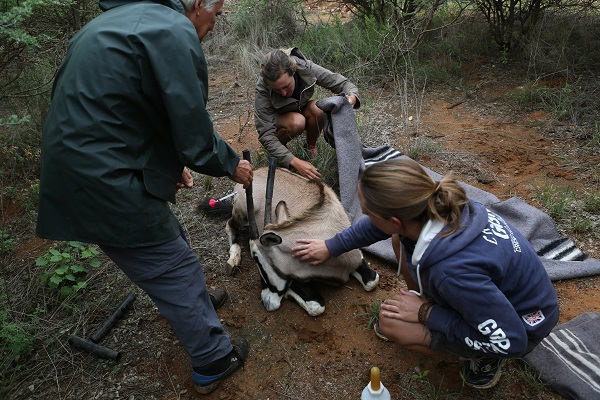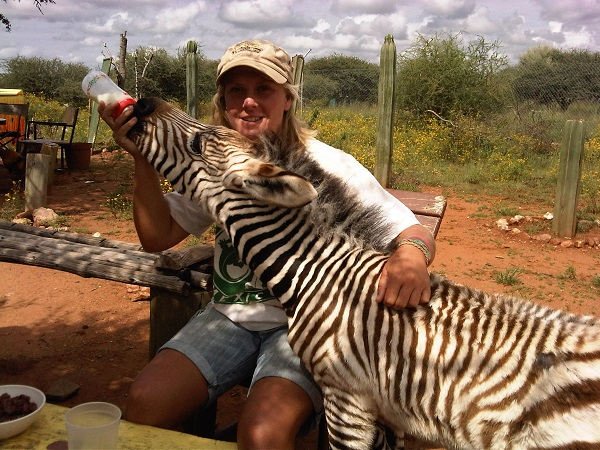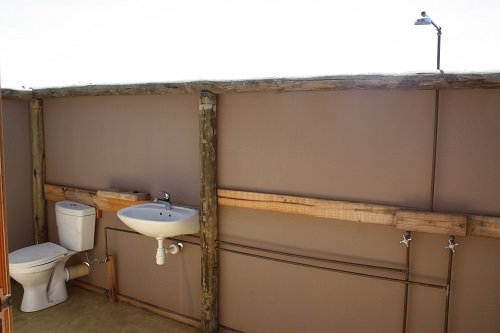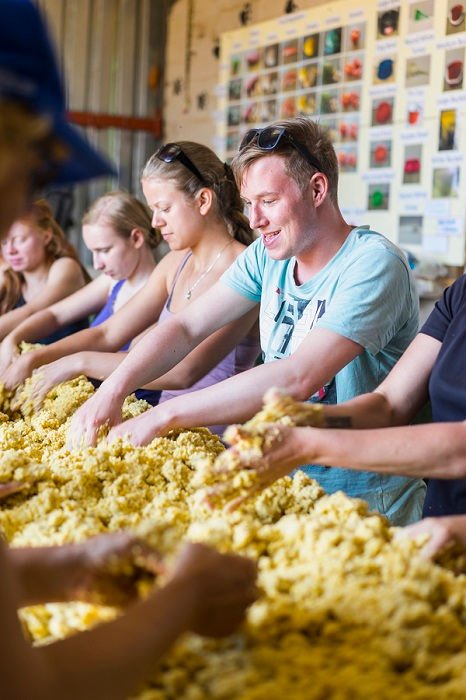NAMIBIA
WILDLIFE SANCTUARY VOLUNTEER PROGRAM
WILDLIFE CONSERVATION SANCTUARY VOLUNTEER
This wildlife sanctuary is now one of the world most renowned wildlife sanctuaries in southern Africa. A mere 45km’s from the Namibian capital of Windhoek, this wildlife sanctuary is aimed at those animals in need of rescue, rehabilitation and, if necessary, permanent captive care. The majority of the animals that visit the Sanctuary are those that have fallen victim to the on-going human-wildlife conflict in Africa.
The daily care, food preparation and feeding of the animals at the Sanctuary, whether rehabilitating or permanent residents, is a duty that falls to the volunteers, and one that is of vital importance. Furthermore, the enrichment and other activities that volunteers are involved in, provide the animals with a great deal of enrichment and comfort during this stressful period. Sleeping with the baby baboons is another important task that enriches not only the lives of the baboons themselves, but the volunteers as well.
Research that is conducted by the Sanctuary involves the setting and maintenance of camera traps and conducting game counts, as well as analysing the data gathered to better understand the behaviour and movements of the animals. Horseback riding is another activity that involves the volunteers in a hands-on manner. This gives volunteers a chance to get up close and personal with Namibia’s wildlife.
For the past 10 years the Wildlife Sanctuary has helped to educate their employee’s children, establishing the Clever Cubs School on the property. Singing, dancing and playing are all part of the full curriculum learning process, and volunteers will be spending at least some of their time assisting the teacher and educating the children.
The daily care, food preparation and feeding of the animals at the Sanctuary, whether rehabilitating or permanent residents, is a duty that falls to the volunteers, and one that is of vital importance. Furthermore, the enrichment and other activities that volunteers are involved in, provide the animals with a great deal of enrichment and comfort during this stressful period. Sleeping with the baby baboons is another important task that enriches not only the lives of the baboons themselves, but the volunteers as well.
Research that is conducted by the Sanctuary involves the setting and maintenance of camera traps and conducting game counts, as well as analysing the data gathered to better understand the behaviour and movements of the animals. Horseback riding is another activity that involves the volunteers in a hands-on manner. This gives volunteers a chance to get up close and personal with Namibia’s wildlife.
For the past 10 years the Wildlife Sanctuary has helped to educate their employee’s children, establishing the Clever Cubs School on the property. Singing, dancing and playing are all part of the full curriculum learning process, and volunteers will be spending at least some of their time assisting the teacher and educating the children.
- Age: min. 18
- Location: Windhoek, Namibia
- Requirements: good physical fitness, flexible
- Group size: 16 - 65 participants
- Project duration: 1 week - 12 weeks
- Laundry: Included - weekly
- WIFI: No WIFI available, except for emergencies
- Linen/towels:Linen and towels provided. Bring your own bath-towel
Location
The project is located 45km from Windhoek.
Requirements
Volunteers and students from all across the globe and from any age above 18 years old are welcome. You need to speak English while working on our sites. If English is not your first language, you should be able to speak it reasonably fluently.
Training/qualifications
A good level of fitness is recommended. However, activities can be tailored to suit the fitness needs and levels of most people. Appropriate footwear is required.
Volunteer's day
The volunteering schedule works on a rotational group system, which ensures you get to experience as many of the Naankuse activities as possible.
The groups work two to three activities a day between the hours of 8am and 5pm. Volunteers get a short break in the morning followed by lunch from 1pm-2:30pm.
Weekends are not part of the rotation schedule; on Saturdays, volunteers participate in certain activities in the morning, and a fun non-work related activity will take place in the afternoon followed by a braai (barbecue). On Sunday, a small team will participate in food prep in the morning and a different small team will participate in the afternoon, so you will have half the day off. All non-working hours are free time to explore the sanctuary.
Wildlife Sanctuary
Situated a mere 45km from Namibia’s capital Windhoek, Naankuse Foundation Wildlife Sanctuary plays home to a variety of animals in need of rescue, rehabilitation, and subsequent release back in to the wild. Originally started as a small wildlife sanctuary, Naankuse is now a world-renowned and infamous conservation organisation that provide both a home and a haven for those animals effected through conflict with humans. The struggle of human-wildlife conflict in Africa is real and very present. Although the ultimate goal is to release an animal back into the wild, some animals that have been too badly injured or abused, ill or habituated are allowed to remain at the Sanctuary, and it is here where the necessity and importance of volunteers comes into play.
A passion for helping and a love for animals is what brings our volunteers together, no matter their background, experience or nationality. From no experience at all, to careered professionals in veterinary sciences and conservation, all aiding in the protection and conservation of Africa precious and diverse wildlife species, is a task to be taken on by anyone. Simple but essential daily volunteer tasks include things like the feeding and daily care of the animals that are housed at the sanctuary, as well as those only here for a temporary stay. Maintaining and developing the Sanctuary is also on the top of the to-do list.
Wildlife Conservation volunteers have the perfect opportunity to get hands-on and directly involved in the conservation efforts in Africa, including the many different aspects of animal care in general. Aside from the main focus being animal welfare, educational and recreational programs are also available for the volunteers. Apart from the daily feedings and other tasks, volunteers should be ready to get actively involved with any and all of the day-to-day activities, as far as their abilities allow of course. This way, volunteers get the most out of their time here, while increasing their skill set and knowledge first hand, furthering efforts in supporting the Foundation.
Unfortunately not all of the animals that reach the Sanctuary are able to be released back into the wild. Their injuries or illness may not allow them to live a healthy, natural life outside of the Sanctuary, thus potentially putting themselves and others at further risk. These animals will remain at the Sanctuary for the remainder of their lives, and their daily care needs need to be met. Animals at the Sanctuary vary from time to time, due to the relocation and/or release policy, and as such, no guarantees of any animals during your time at the Sanctuary can be made. Although the animals at the Sanctuary vary at any given time, your time here may be shared with animals such as: Carnivore – wild dogs, lions, leopards, cheetah and caracal; Primates – vervet monkeys and baboons; Birds – peacocks and vultures; Antelope – oryx (gemsbok), springbok, duiker and kudu; Small Mammals – meerkat, rock dassie, polecats, genets and warthog. These just some of the staple species that can be found at the Sanctuary, not to mention a host of other creatures and farm animals.
Activities at the Sanctuary
Thanks to the rotational group system, every volunteer gets a chance to be involved in pretty much every aspect of the sanctuary experience. Some of the possible daily tasks and duties of the Wildlife Conservation Volunteers around the Sanctuary include:
Research
Research is one of the most important aspects of the Sanctuary, and as such, is conducted through a variety of different activities by the research team. The research conducted during the time of your stay is determined solely by the subject(s) of the research team at the time. During their stay, volunteers will be involved in the setting of camera traps and conducting game counts. This information and data will then be analysed to gain a better insight and understanding into the animal’s behaviour, their health and their movements around the farm. This allows volunteers to get plenty of time on the ground and is a great way to experience the Namibian wilderness.
The data that is collected is essential with regards to monitoring the Sanctuaries wildlife populations, which include: carnivore, giraffe and a variety of antelope, as well as for the purposes of focusing on the human-wildlife conflict that is the cause of the majority of the problems seen at the Sanctuary. This human-wildlife conflict research includes carnivores, snakes and primates. If it’s your lucky day, you may get called up to help out the Research Rapid Response Unit who are usually called out to collar a wild carnivore. This is an absolute privilege for any volunteer. Horseback Riding Horse lovers are in luck, as volunteers may be lucky enough to do some horse riding through the veldt, assuring them of some close encounters of the African wildlife kind. Game counts conducted on horseback may be another activity conducted during your stay, and are a great way to see the bushveld, all the while enjoying this unique experience in the African bush.
Clever Cubs School
This pre-school was opened in 2009, and has since been dedicated to the education of the San Bushman children whose parents work for the project. Volunteering will entail that during your stay at the Wildlife Conservation Project, you will be spending some of your time teaching the children, and assisting the teacher at the Clever Cubs School. This school provides the children with the necessary free education that they do not have access to anywhere else.
The school teaches the children how to read and write while they enjoy dancing, singing and playing during the day. A full curriculum including Mathematics, English, Science, Arts and Crafts, Sports and Environmental Studies is additionally taught to the toddlers and children. Currently, efforts are being made to enrol these children into the mainstreams schools in the country’s capital Windhoek, to help continue, and further, their education. As the school is located on the Sanctuary grounds, volunteers may choose to spend their time assisting the teacher. If this is the case, it is asked that volunteers provide this information in advance. Even though this can be done upon arrival, or throughout the duration of your participation in the project, it is best to indicate this information early. If you choose to focus solely on the school for the duration of your stay, please indicate so at the time of your booking and reservation.
Accommodation & meals
Two options of accommodation at the Wildlife Sanctuary; volunteer rooms with up to four people (same gender) sharing each room, or large tents with a living and bedroom area to be shared by up to two or three people (same gender or a couple). The furnishings are basic with comfortable single beds with bedding provided (duvets and pillows) - no air con. Showers and toilet facilities are communal and hot water is supplied by solar energy and therefore sometimes restricted. Power sockets for electrical items are available in communal areas.
Electricity is 220 Volts and the main socket type is earthed with three pins (as used in South Africa – Type M). Please bring plug adaptors so you can charge mobile phones and cameras.
Naankuse is fully fitted with electricity. Power sockets are available in the communal lapa area for recharge, however adaptors must be self supplied.
Power cuts do occur and can be prolonged (longer than 24 hours), particularly in the rainy season.
Meals
Three meals are provided on a help yourself basis - Breakfast includes toast and cereal; Lunch includes pasta, wraps, burgers or stir-fry; and Evening Dinners include meat, fish and vegetables with rice, potatoes or pasta. On weekends, there is often a braai (barbecue)
Kiosk
The sanctuary has a bar that sells drinks and snacks in the evenings (except Sundays) and a shop that sells merchandise in the afternoons on Mondays, Tuesdays, Wednesdays and Fridays (closed on Thursday and weekends). While toiletries, cosmetics or sunscreen are not sold in this shop, Sunday trips to Windhoek may be available to purchase such items.
The project is located 45km from Windhoek.
Requirements
Volunteers and students from all across the globe and from any age above 18 years old are welcome. You need to speak English while working on our sites. If English is not your first language, you should be able to speak it reasonably fluently.
Training/qualifications
A good level of fitness is recommended. However, activities can be tailored to suit the fitness needs and levels of most people. Appropriate footwear is required.
Volunteer's day
The volunteering schedule works on a rotational group system, which ensures you get to experience as many of the Naankuse activities as possible.
The groups work two to three activities a day between the hours of 8am and 5pm. Volunteers get a short break in the morning followed by lunch from 1pm-2:30pm.
Weekends are not part of the rotation schedule; on Saturdays, volunteers participate in certain activities in the morning, and a fun non-work related activity will take place in the afternoon followed by a braai (barbecue). On Sunday, a small team will participate in food prep in the morning and a different small team will participate in the afternoon, so you will have half the day off. All non-working hours are free time to explore the sanctuary.
Wildlife Sanctuary
Situated a mere 45km from Namibia’s capital Windhoek, Naankuse Foundation Wildlife Sanctuary plays home to a variety of animals in need of rescue, rehabilitation, and subsequent release back in to the wild. Originally started as a small wildlife sanctuary, Naankuse is now a world-renowned and infamous conservation organisation that provide both a home and a haven for those animals effected through conflict with humans. The struggle of human-wildlife conflict in Africa is real and very present. Although the ultimate goal is to release an animal back into the wild, some animals that have been too badly injured or abused, ill or habituated are allowed to remain at the Sanctuary, and it is here where the necessity and importance of volunteers comes into play.
A passion for helping and a love for animals is what brings our volunteers together, no matter their background, experience or nationality. From no experience at all, to careered professionals in veterinary sciences and conservation, all aiding in the protection and conservation of Africa precious and diverse wildlife species, is a task to be taken on by anyone. Simple but essential daily volunteer tasks include things like the feeding and daily care of the animals that are housed at the sanctuary, as well as those only here for a temporary stay. Maintaining and developing the Sanctuary is also on the top of the to-do list.
Wildlife Conservation volunteers have the perfect opportunity to get hands-on and directly involved in the conservation efforts in Africa, including the many different aspects of animal care in general. Aside from the main focus being animal welfare, educational and recreational programs are also available for the volunteers. Apart from the daily feedings and other tasks, volunteers should be ready to get actively involved with any and all of the day-to-day activities, as far as their abilities allow of course. This way, volunteers get the most out of their time here, while increasing their skill set and knowledge first hand, furthering efforts in supporting the Foundation.
Unfortunately not all of the animals that reach the Sanctuary are able to be released back into the wild. Their injuries or illness may not allow them to live a healthy, natural life outside of the Sanctuary, thus potentially putting themselves and others at further risk. These animals will remain at the Sanctuary for the remainder of their lives, and their daily care needs need to be met. Animals at the Sanctuary vary from time to time, due to the relocation and/or release policy, and as such, no guarantees of any animals during your time at the Sanctuary can be made. Although the animals at the Sanctuary vary at any given time, your time here may be shared with animals such as: Carnivore – wild dogs, lions, leopards, cheetah and caracal; Primates – vervet monkeys and baboons; Birds – peacocks and vultures; Antelope – oryx (gemsbok), springbok, duiker and kudu; Small Mammals – meerkat, rock dassie, polecats, genets and warthog. These just some of the staple species that can be found at the Sanctuary, not to mention a host of other creatures and farm animals.
Activities at the Sanctuary
Thanks to the rotational group system, every volunteer gets a chance to be involved in pretty much every aspect of the sanctuary experience. Some of the possible daily tasks and duties of the Wildlife Conservation Volunteers around the Sanctuary include:
- Preparing the food and feeding of the farm animals and the wildlife
- Cleaning and maintaining the enclosures
- Provide the animals with enrichment activities and interaction, i.e. walks in the bush, or any other implemented activity specialised for them
- Intensive care must be provided for the juvenile wildlife at the Sanctuary, including some possible overnight care for the baby baboons
- Building of new structures and facilities requires physical labour
- Research, that includes the monitoring of free-ranging carnivores in and around the area, as well as analysing camera traps and other GPS data
- Spend time in the bush tracking and monitoring carnivore and snake activity around the property
- Game counts in the bush and horseback riding
- Assisting with any new projects or initiatives that arise during your time at the Sanctuary
Research
Research is one of the most important aspects of the Sanctuary, and as such, is conducted through a variety of different activities by the research team. The research conducted during the time of your stay is determined solely by the subject(s) of the research team at the time. During their stay, volunteers will be involved in the setting of camera traps and conducting game counts. This information and data will then be analysed to gain a better insight and understanding into the animal’s behaviour, their health and their movements around the farm. This allows volunteers to get plenty of time on the ground and is a great way to experience the Namibian wilderness.
The data that is collected is essential with regards to monitoring the Sanctuaries wildlife populations, which include: carnivore, giraffe and a variety of antelope, as well as for the purposes of focusing on the human-wildlife conflict that is the cause of the majority of the problems seen at the Sanctuary. This human-wildlife conflict research includes carnivores, snakes and primates. If it’s your lucky day, you may get called up to help out the Research Rapid Response Unit who are usually called out to collar a wild carnivore. This is an absolute privilege for any volunteer. Horseback Riding Horse lovers are in luck, as volunteers may be lucky enough to do some horse riding through the veldt, assuring them of some close encounters of the African wildlife kind. Game counts conducted on horseback may be another activity conducted during your stay, and are a great way to see the bushveld, all the while enjoying this unique experience in the African bush.
Clever Cubs School
This pre-school was opened in 2009, and has since been dedicated to the education of the San Bushman children whose parents work for the project. Volunteering will entail that during your stay at the Wildlife Conservation Project, you will be spending some of your time teaching the children, and assisting the teacher at the Clever Cubs School. This school provides the children with the necessary free education that they do not have access to anywhere else.
The school teaches the children how to read and write while they enjoy dancing, singing and playing during the day. A full curriculum including Mathematics, English, Science, Arts and Crafts, Sports and Environmental Studies is additionally taught to the toddlers and children. Currently, efforts are being made to enrol these children into the mainstreams schools in the country’s capital Windhoek, to help continue, and further, their education. As the school is located on the Sanctuary grounds, volunteers may choose to spend their time assisting the teacher. If this is the case, it is asked that volunteers provide this information in advance. Even though this can be done upon arrival, or throughout the duration of your participation in the project, it is best to indicate this information early. If you choose to focus solely on the school for the duration of your stay, please indicate so at the time of your booking and reservation.
Accommodation & meals
Two options of accommodation at the Wildlife Sanctuary; volunteer rooms with up to four people (same gender) sharing each room, or large tents with a living and bedroom area to be shared by up to two or three people (same gender or a couple). The furnishings are basic with comfortable single beds with bedding provided (duvets and pillows) - no air con. Showers and toilet facilities are communal and hot water is supplied by solar energy and therefore sometimes restricted. Power sockets for electrical items are available in communal areas.
Electricity is 220 Volts and the main socket type is earthed with three pins (as used in South Africa – Type M). Please bring plug adaptors so you can charge mobile phones and cameras.
Naankuse is fully fitted with electricity. Power sockets are available in the communal lapa area for recharge, however adaptors must be self supplied.
Power cuts do occur and can be prolonged (longer than 24 hours), particularly in the rainy season.
Meals
Three meals are provided on a help yourself basis - Breakfast includes toast and cereal; Lunch includes pasta, wraps, burgers or stir-fry; and Evening Dinners include meat, fish and vegetables with rice, potatoes or pasta. On weekends, there is often a braai (barbecue)
Kiosk
The sanctuary has a bar that sells drinks and snacks in the evenings (except Sundays) and a shop that sells merchandise in the afternoons on Mondays, Tuesdays, Wednesdays and Fridays (closed on Thursday and weekends). While toiletries, cosmetics or sunscreen are not sold in this shop, Sunday trips to Windhoek may be available to purchase such items.
Dates
All volunteers will be collected from Windhoek airport and dropped of at the wildlife sanctuary, arriving on either Monday or Thursday - departing on Monday or Thursday.
Rates
Rates includes
All volunteers will be collected from Windhoek airport and dropped of at the wildlife sanctuary, arriving on either Monday or Thursday - departing on Monday or Thursday.
Rates
| Duration | Fees |
|---|---|
| 2 weeks | 22500 NDS |
| 3 weeks | 32000 NDS |
| 4 weeks | 42000 NDS |
- Project placement
- Airport transfers on arrival and departure
- Accommodation (twin or triple room/tent, full-board, laundry service)
- An orientation on arrival
- Electronic certificate (printed copy on request)
- Local support including 24-hour emergency number
- Research site supplement includes: transfers and additional operational costs
- Flights to Windhoek, Namibia
- Visa fees
- Travel Insurance
- Uniform
- Beverages & Snacks
- WIFI
Click here to sign up.
